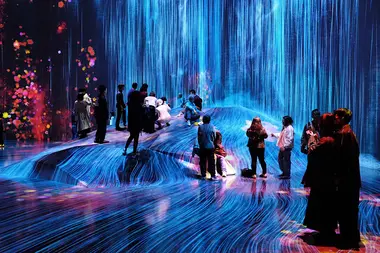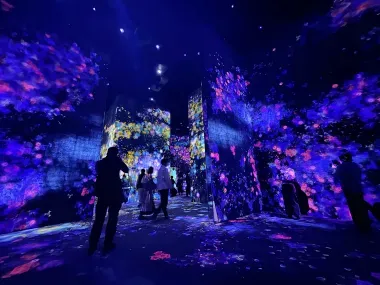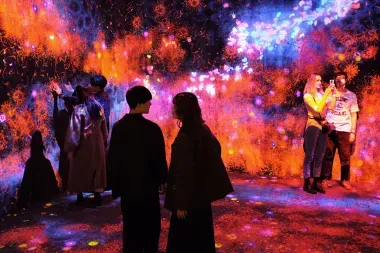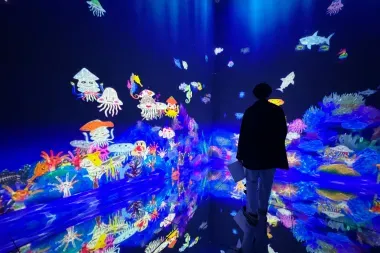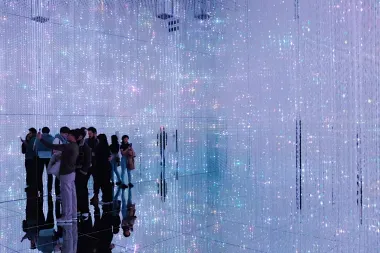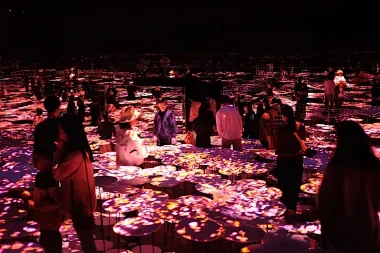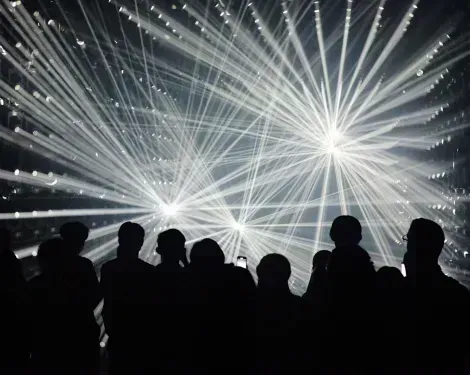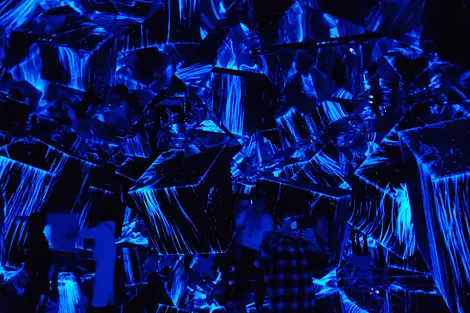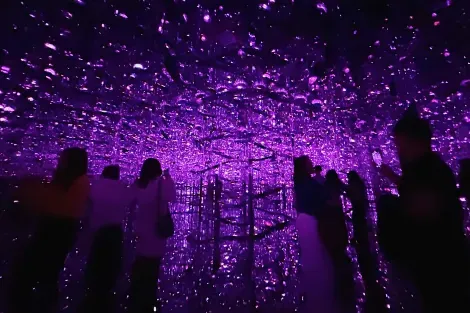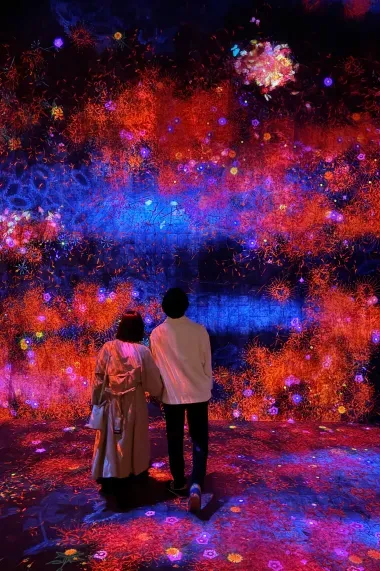TeamLab Borderless: reopened and reimagined at Azabudai Hills
- Published on : 22/02/2024
- by : Joshua Mueda
- Youtube
Few art collectives have garnered the international recognition and appeal of the TeamLab group, initially founded in 2001 in Tokyo, Japan. Consisting of an extensive team of visual artists with varying specialties in CG art, engineering, programming, and even architecture, TeamLab specializes in cutting-edge, technology-based art installations and exhibitions found all throughout Japan and the world with varying themes.
In the collective’s place of founding, two of its most praised exhibitions are open for viewing: TeamLab Planets and TeamLab Borderless. Borderless was initially opened in 2018, located on the island of Odaiba in Tokyo Bay. In late 2022, the initial location for Borderless was closed, but between those years, it attracted upwards of 2 million visitors from all over the world, becoming the most visited single art museum exhibition in the world. As of February 9th, 2024, it has since relocated to the newly-opened Azabudai Hills complex in the Minato-Ward.
Since completion, Azabudai Hills stands as the current tallest building in all of Japan and serves as a new commercial and cultural center in one of the city’s most prolific districts. The remixed and reimagined TeamLab Borderless is the perfect accompaniment to the new “modern urban village,” presenting an essential set of attractions for locals and travelers alike. We’ll take a look at the digital exhibition, its returning classic installations, and new introductions that are sure to wow visitors!
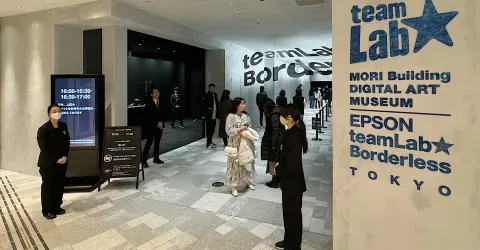
Entrance to TeamLab Borderless
Joshua Mueda
“Wander, Explore, and Discover”
Upon entering the exhibit, visitors are initially shown an instructional video. Said video emphasizes that TeamLab Borderless has no dedicated maps or routes for visitors to follow, and that, in fact, many of the rooms and their installations are unmarked. Artwork on walls and in rooms also constantly change and move in real time, promoting revisits to certain rooms. Even passing through the same hallways presents a new experience every time.
“Wander, Explore, and Discover” appear on the screen and are reiterated a number of times throughout the instructional video. These three words encapsulate the theme of Borderless, largely relevant to the exhibit’s namesake: no set lines and no special instructions (aside from staying safe, of course).
The works of TeamLab can be difficult to describe on paper, as they are oftentimes installations meant to be experienced with a medley of the senses. Far beyond simply what can be seen with the eyes, TeamLab will often utilize dynamic backing soundtracks and materials varying in texture that are as much a visual treat as they are to touch. TeamLab’s ability to also utilize the lack of senses to invoke certain atmospheres and sensations is also on full display at Borderless.
Notable attractions and returning favorites
The initial room that visitors will enter after watching the user guide consists of tall-standing walls with LED panels and moving images such as flower and foliage motifs, marching animals significant to Japanese folklore and history, moving calligraphy, and more. The walls are often able to be interacted with, with the designs reacting to touch and movement.
This maze of in-motion artwork is dubbed “Borderless World” and deviates to different parts of the exhibit, but at the center is a large circular room with an elevated formation against the back wall that is climbable. Different visuals have different names, including “What a Loving, and Beautiful World” and “Reversible Rotation: Flying Beyond Borders.”
Those revisiting the exhibit since its move from Odaiba will be able to explore and find some beloved returning favorites, such as the room of artificial lily pads with nature-inspired imagery projected on them. Navigating to this room will often have visitors stumble into a wall of stark darkness that is slowly illuminated as the projections start up.
The iconic “Infinite Crystal World” continues to be one of the most representative installations at TeamLab Borderless, consisting of LED node chains hanging from a high ceiling of a room made entirely of mirror panels. The light fixtures reflected off the walls create an illusion of infinite sparkles.
One of the more personalized attractions and a favorite of the Odaiba location, the “Future Park,” encourages creativity from visitors. In a separate room, handmade sketches can be made and submitted to be presented on the walls of the adjacent “Sketch Ocean” room. There is also merchandise for sale that can have sketches printed on them to bring back home.
Relocated, Reimagined
With its new location in the basement of the Garden Plaza buildings in Azabudai Hills, TeamLab Borderless has also introduced four new major installations, each presenting the core sensory interactions and technology-focused spectacle that have made the exhibit so popular to begin with.
Heavily marketed with the reopening of the exhibit is the charmingly named "Bubble Universe," consisting of glass orbs hanging from the ceiling with soft illuminating light. Much like the Infinite Crystal World, this attraction is set up in a mirror room, allowing the lights to reflect throughout and create a sea of glowing orbs.

"Bubble World" at TeamLab Borderless at Azabudai Hills
@kamechan.in.japan
Near the main entrance is the rave-like “Light Sculpture” installation. Though not as liberal in its space for spectator movement as other works in the exhibition, this room provides an impressive visual show consisting of swiveling spotlights and smoke. Light appears to manifest into a solid object, and different themes cycle through with different techniques, colors, and music to provide environments of varying intensity.
The “Microcosmoses” section sticks to the tried-and-true formula of LED lights and mirrors, though in this iteration, the element of movement is added as illuminated orbs run through a track. Each orb is able to emanate up to 43 different colors, and the combination of the changing designs within the orbs, the changing movements on the rails, and the reflections of the mirrors mimics the imagery of a shooting-star-filled night sky.
The Return of a Tokyo Staple
The two- year hiatus of TeamLab Borderless left some questions for visitors and residents of the Japanese capital alike. Would the move be warranted? Would two years of ceased operations deliver anything new?
With the attraction moving more towards the city center and as a major draw of the prospective Azabudai Hills complex, the exhibit’s role as a major piece of Tokyo’s art scene is likely only further enforced. Additionally, the new layout, added artwork, and new installations differentiate it enough from its former iteration that it will attract new visitors and original appreciators alike. Tokyo, being the artistic hub that it is, can proudly boast the return of the world’s most popular art museum, with the flourishing urbanscapes of a new age Tokyo surrounding it.

